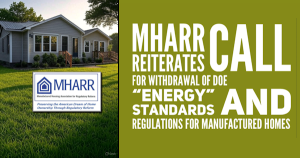[vc_row][vc_column][vc_column_text]Washington, D.C., May 8, 2017 – The Manufactured Housing Association for Regulatory Reform (MHARR) has formally called on the U.S. Environmental Protection Agency (EPA) to withdraw certification requirements contained in its December 2016 Formaldehyde Emissions Standards for Composite Wood Products rule, which discriminate against manufactured housing and manufactured housing producers.
At a May 1, 2017 meeting in Washington, D.C. convened by EPA to solicit comments from interested parties on a new rulemaking docket concerning regulations adopted under the Toxic Substances Control Act (TSCA) and other laws that could be “repealed, replaced, or modified to make them less burdensome” in accordance with Executive Order (EO) 13777 (“Enforcing the Regulatory Agenda”), issued by President Trump on February 24, 2017, MHARR President and CEO Mark Weiss called for the elimination of certification requirements for “finished goods” included in the final rule, which apply to manufactured housing producers but expressly exempt site-builders using the same materials. MHARR was the only manufactured housing industry organization to participate in the meeting and address the formaldehyde rule specifically in relation to manufactured homes.
In a verbal statement presented at the meeting, MHARR noted that the final Formaldehyde rule published by EPA during the last days of the Obama Administration was significantly different from the proposed rule, published on June 10, 2013. Specifically, section 770.3 of the final rule includes, within the definition of composite wood “finished goods,” an express exemption for site-built structures that was not part of the proposed rule. That exception states, in relevant part, “site-built buildings or other site-built real property improvements are not considered finished goods.” Thus, under the proposed EPA rule, both manufactured homes and site-built homes would have been deemed “finished goods,” and subject to the certification requirements applicable to “finished goods.” By contrast, under the final rule, only manufactured homes and manufactured home-builders are subject to those certification requirements (providing, essentially, for a certification that the “finished good” incorporates only formaldehyde emission-compliant composite wood products) and related regulatory compliance costs.
In support of this change, made on the basis of “supplemental” comments submitted by the National Association of Home Builders (NAHB) after the close of the general public comment period for the proposed rule, EPA purported to divine, in the Formaldehyde Emissions Standards for Composite Wood Products Act – which led to the development and promulgation of the EPA standards – a “legislative intent” with respect to “finished goods” to “regulate [only] goods that move freely through commerce and that are produced through a manufacturing process at a manufacturing facility, not objects like buildings or other structures that are constructed on site and become a permanent addition to real property.”
In response to this post-hoc rationalization, MHARR first noted that there is absolutely no textual basis in the underlying statute to support any such intent. The Act itself, in section 601(a)(1)(B), expressly sets forth congressional exceptions to the definition of a “finished good,” but contains no exception for site-built homes. Clearly, if Congress had wanted to create the kind of broad exception “discovered” by EPA through process of “interpretation,” it could and would have done so itself. Thus, there is no legitimate basis for any administrative exception to the Act, but if EPA insists on creating one via statutory “interpretation,” it may not and must not be discriminatory in nature.
Second, MHARR noted that the alleged distinction in congressional “intent” was – and is — factually void. MHARR emphasized that the only difference between the construction of a manufactured home and a site-built home, is that one is built in a factory, under controlled conditions, and the other is built outdoors, which does not provide a valid or legitimate basis for a consequential regulatory distinction between the two.
MHARR thus maintained in its verbal statement – which will be further amplified in written comments to EPA – that the final formaldehyde rule effectively discriminates against manufacturers using a particular building process with no rational basis to support any such distinction. As a consequence, MHARR called on EPA to eliminate the “finished good” certification requirements imposed on manufactured housing producers by the final rule, and to treat manufactured home builders in the same manner that it treats site builders.
In Washington, D.C., MHARR President and CEO Mark Weiss stated: “EPA’s discriminatory imposition of ‘finished good’ certification requirements on manufactured home builders while exempting site-builders from those same requirements, is both baseless and arbitrary, as even a cursory reading of the underlying statute shows. And that is without even getting into the procedural gymnastics used by EPA to change the final rule based on a re-opening of the public comment period to address – supposedly – a completely unrelated issue. With new leadership at EPA, though, and with President Trump’s regulatory Executive Orders, the industry will have an opportunity to seek changes to the rule to reduce the regulatory burdens imposed on the industry and the millions of lower and moderate-income American families that rely on affordable, non-subsidized manufactured housing.”
The Manufactured Housing Association for Regulatory Reform is a Washington, D.C.-based national trade association representing the views and interests of independent producers of federally-regulated manufactured housing.[/vc_column_text][/vc_column][/vc_row]













